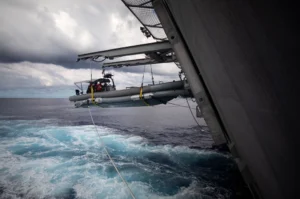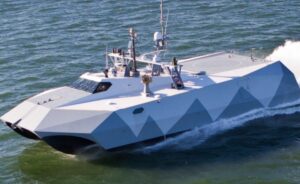The Navy issued a Request for Information (RFI) on Oct. 26 seeking information from industry, academia, and government research and development organizations on radars to be used on unmanned surface vessels (USVs) for hazard avoidance in upcoming testing.
According to the solicitation, the Navy is specifically seeking commercial or government radar marine perception systems to be used in a Capability Demonstration (CD) on USVs.

The capabilities and characteristics of systems the Navy selects will be demonstrated on water trials, with results used to “inform decision makers of emerging and available solutions that may enhance or improve existing capabilities.”
The RFI noted this is sponsored by the Under Secretary of Defense for Research & Engineering, Capabilities and Prototypes along with the Program Executive Office Unmanned and Small Combatants’ PMS 420 LCS Mission Modules program and Naval Sea Systems Command’s Naval Surface Warfare Centers.
The Office of the Secretary of Defense’s OSD for Research and Engineering’s Capabilities and Prototypes Joint Prototyping and Experimentation Maritime (JPEM) program will ultimately plan and execute the demonstration using its JPEM Stilleto maritime technology demonstration platform.
The RFI said the Navy is interested in state of the art radars that can be used on small USVs, specifically an 11 meter Rigid Inflatable Boat (RIB) for obstacle avoidance.
“The marine radar tracking system is needed to provide actionable information, in the form of track reports, to inform obstacle avoidance for unmanned surface vessels with no human input. Track reports need to include, at minimum, the following data fields: timestamp, track identifier, latitude, longitude, speed, and course,” the notice said.
The Navy said it prefers radar sensors with solid state power amplifier systems, including Frequency-Modulated Continuous-Wave systems, as long as the size, weight and power requirements are compatible with the 11-meter RIB size craft.

“Selected systems will be evaluated based on their ability to detect and track targets in a relevant maritime environment. Planned surface targets / obstacles may include buoys/markers and/or maritime vessels,” the notice said.
The RFI said this effort seeks to “accelerate the delivery of innovative capabilities and technologies to the warfighter by demonstrating and experimenting in an operationally relevant environment. The results of this effort will foment learning and innovation that rapidly develops technologies and techniques to improve warfighting capability and assist in quicker leadership decision making.”
The notice also said the Navy and DoD hope to gain insight into technology gaps and emerging needs.
“The demonstration and experimentation environment enables a collaborative working relationship between government organizations, academia, and industry. This promotes the identification of emerging needs and an assessment of maturing technologies with the primary goal of accelerating the delivery of technology discoveries to the Department of Defense and interagency partners.”
Interested parties are directed to submit an application describing the marine radar system and perception capabilities by Nov. 18. The Navy is limiting technologies of interest to radar sensors with integrated tracking software or tracking software that can integrate with standard radar outputs.
The demonstration event is planned for Dec. 5 – 16 and will occur off the coast of the Joint Expeditionary Base – Little Creek Fort Story in Virginia Beach, Va.
JPEM expects to use Cooperative Research and Development Agreements (CRADA) with private industry partners selected for the CD.